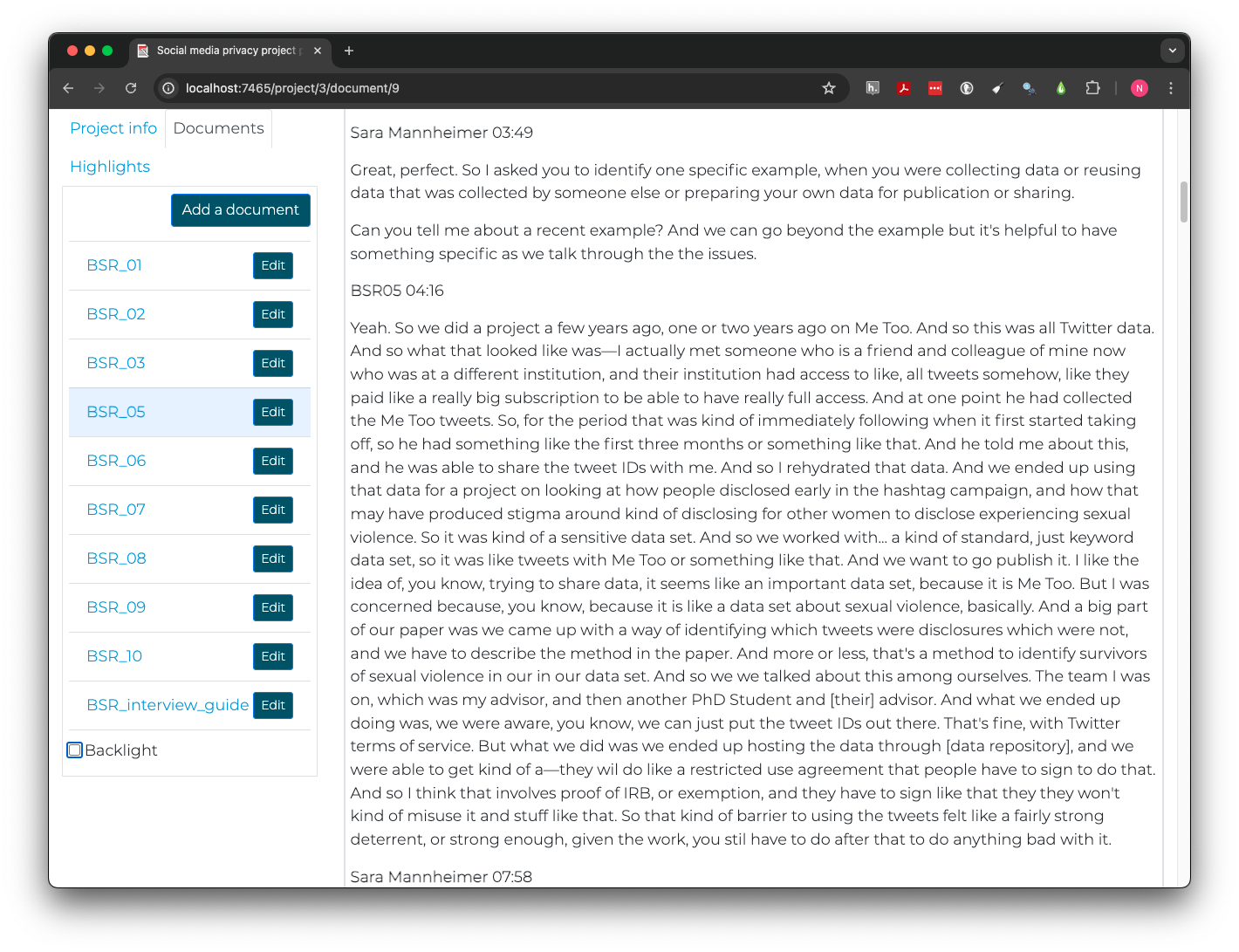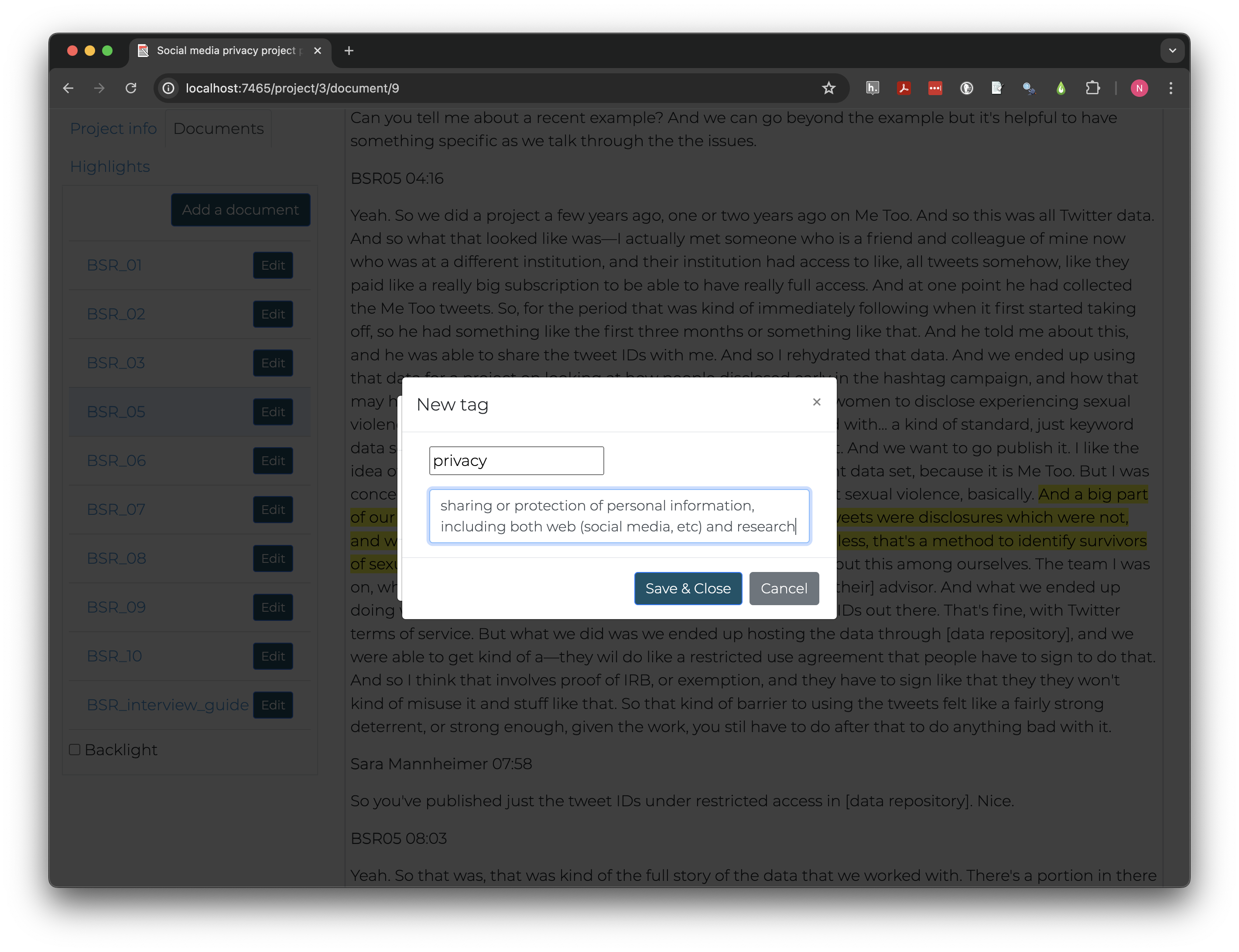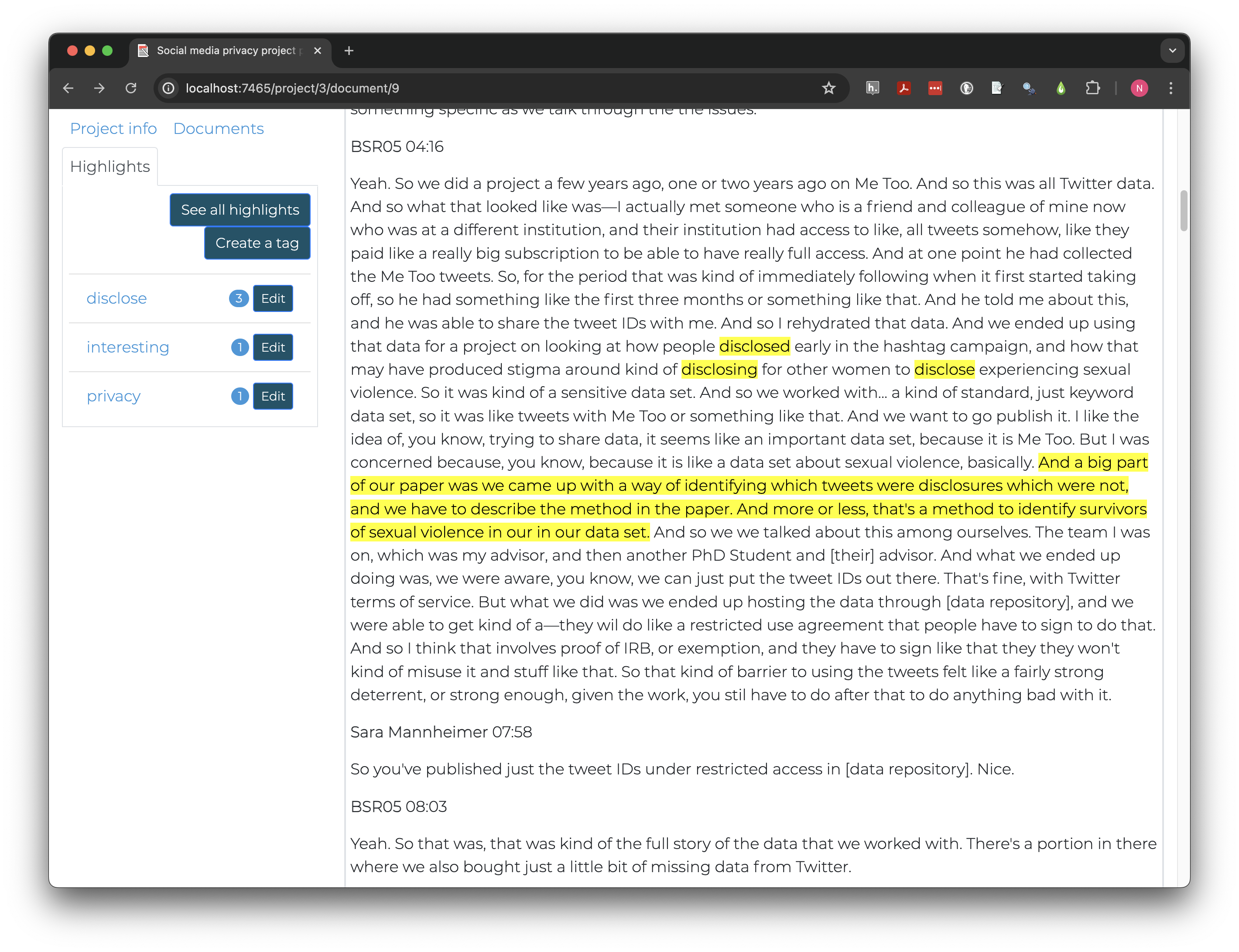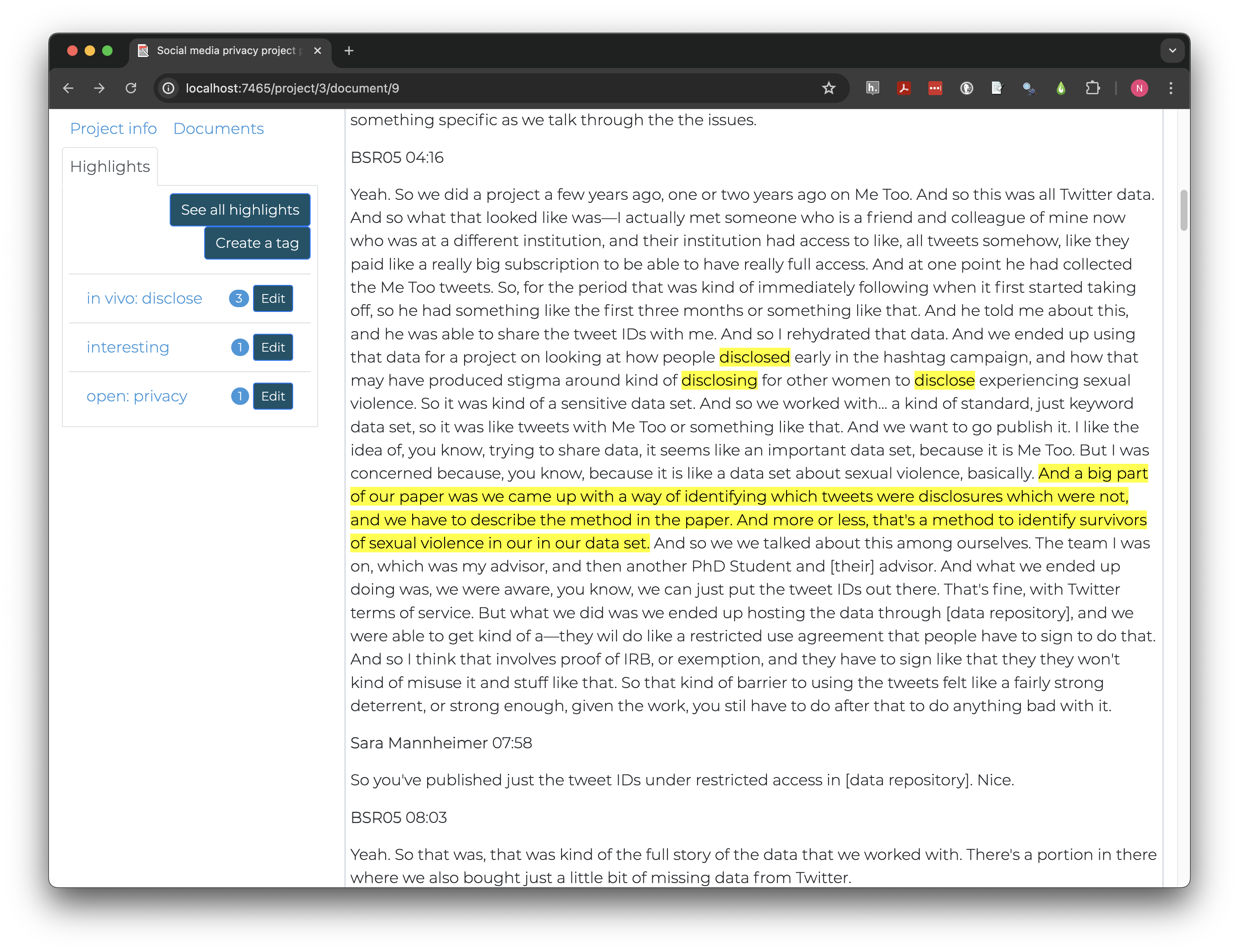Best Practices for Qualitative Coding
Last updated on 2024-07-31 | Edit this page
Overview
Questions
- What is the difference between inductive and deductive coding?
- How can I set up and apply a flexible code tree in Taguette?
- How can I create and view highlights in Taguette?
Objectives
- Distinguish between inductive and deductive approaches to coding
- Develop deductive codes relevant to project objectives
- Create and view highlights in Taguette
Beginning qualitative researchers often want to jump right into analyzing their data once documents are added to their project, but taking the time to develop a coding protocol first can save time while improving the transparency and quality of research.
The first step is typically to choose a coding philosophy, that is, to decide how and why code labels will be chosen and applied. Coding philosophies range along a spectrum from inductive to deductive approaches.
Deductive and Inductive Reasoning
Deductive reasoning begins from assumptions and hypotheses. It seeks to determine, using logic or data, whether the hypotheses can be shown to be false (or true).
Experimental methods in many disciples follow this pattern. First, a hypothesis or prediction about the effect of some cause is developed based on past research and observation. An experiment is conducted to isolate that specific potential cause, and conclusions are drawn based on the presence (or lack) of difference made by the difference.
A medicine trial is a classic example of a deductive approach. Scientists predict that a medicine will help people in a specific way (for example, by reducing the length of an infection). They recruit participants (patients with the infection) who are randomly assigned so that some receive the medicine and others receive a placebo with no medicine. If the length of the infection is statistically shorter in the patients who received the medicine, that is taken as evidence that the medicine likely produced the desired result.
Deductive reasoning relies on minimizing exposure to outside variables that might affect the outcome of interest, or otherwise statistically adjusting for potential confounding factors.
Inductive reasoning, by contrast, seeks to draw more naturalistic conclusions by making close observations while recognizing personal biases and limits to observation. Inductive qualitative research draws on patterns observed in data to make predictions, generalizations, or analogies about more general patterns. Put differently, deductive research is explanatory in nature, while inductive research is exploratory.
Inductive social research often draws on critical or constructivist perspectives that emphasize how individuals and groups describe their own experience.
Taken in a longer scope, science can only develop through the complementary use of induction and deduction, sometimes visualized as a circular cycle. Observation is used to develop hypotheses, which are tested deductively through more observation. If hypotheses are not fully confirmed, inductive reasoning is used to develop revised or alternative hypotheses.
[FIGURE OF SCIENTIFIC PROCESS]
Even though deductive and inductive reasoning are both part of nearly every study in some way, how qualitative data is coded depends on the general purpose of the study. Exploratory studies tend to adopt an inductive method, while explanatory studies use more deductive approaches to code development.
Inductive coding
In 1967, US sociologists Glaser and Strauss formalized (grounded theory)[https://en.wikipedia.org/wiki/Grounded_theory], one method for conducting structured qualitative research without presupposing a hypothesis or theory. They recognized that how people experience the world (i.e., the economy) can be at least as important as traditional measures (i.e., personal income or gross domestic product).
In grounded theory and other inductive coding methods, qualitative data like interview transcripts are read carefully and initial codes are applied that match the language and interpretation proposed by study participants themselves as closely as possible.
Often, researchers label codes in this open coding phase by using their judgment and experience to discern underlying themes in the experiences expressed across interviews.
In our scenario, the goal of this analysis is to prepare for
collecting and analyzing new data related to social media privacy and
confidentiality. BSR_05 is with a PhD student studying
political communication.
We can open BSR_05 in Taguette from the
Documents tab. The text of the interview should appear on
the right. In the body of the interview, speaker names and the time they
started speaking in the recording appear on one line, followed by what
they said. Sara Mannheimer is the interviewer and
BSR05 replaces the name of the student for privacy
protection.

Scrolling 3 minutes and 49 seconds into the interview, we learn this person was using a large dataset of Twitter posts from the #MeToo movement with some significant privacy risks, for example:
And a big part of our paper was we came up with a way of identifying which tweets were disclosures which were not, and we have to describe the method in the paper. And more or less, that’s a method to identify survivors of sexual violence in our in our data set.
Open coding
Tags (labelled codes) are applied to highlights (text excerpts). Select the two sentences above in Taguette and click “new highlight” then check “interesting” and “Save and Close.” The text should now be highlighted in yellow.
Creating open codes
Discuss as a class what kinds of labels you, as a social media privacy researcher, might apply to part or all of the excerpt above.
Open codes can range from very specific to more general, but theoretically fruitful codes are often somewhere in the middle - general enough to apply in multiple situations but specific enough those excerpts have something more in common.
There are multiple words or phrases that might capture some of this excerpt’s relevance for our research. Taguette allows applying multiple tags to one highlight. Doing so makes it easier to consider overlapping concepts, like “privacy” and “identity protection,” as well as other aspects of the context, such as “sexual violence” or “crime victimization”.
How much to highlight?
Taguette supports multiple tags per highlight but does not allow overlapping highlights, making decisions about how large of excerpts to use more important. Highlights generally should be only long enough to provide context and understand meaning. Some researchers always code full sentences or even paragraphs, while others make decisions case by case.
Let’s create some of the tags we defined in our discussion. Click on the highlight and create additional tags. Names should be short and clear. Adding descriptions can help clarify the difference between similar tags, especially if working collaboratively with others.

The “Highlights” tab at the left allows us to see all the tags we’ve created and to how many highlights each has been applied. I created tags for both “privacy” and “identity protection” but later realized they overlap so much conceptually they don’t need to be separated.
To merge two tags click “Edit” next to the tag you want to remove and click “Merge.” Select the other tag in the “into” box, then “Merge tags.” After merging, any highlights tagged with one or both original tag will have the name of the “into” tag and the other will be removed.
Plan twice; click once
“Measure twice and cut once.” -English proverb meaning one should plan and prepare in a careful, thorough manner before taking action and act once precisely and properly.
Taguette has no undo or history functions. Merged or deleted tags cannot be retrieved. Even if you export a copy of a project before making changes, there is no import functionality to restore the project to its previous state within Taguette.
In vivo coding
An alternative approach to inductive coding, in vivo coding, tries to further reduce researcher bias effects by creating initial code labels only from the language used in the interviews themselves.
Let’s look at a passage slightly earlier in the paragraph we’ve been working with.
And we ended up using that data for a project on looking at how people disclosed early in the hashtag campaign, and how that may have produced stigma around kind of disclosing for other women to disclose experiencing sexual violence. So it was kind of a sensitive data set.
The person being interviewed used a number of words and phrases that may be relevant to data privacy protection in these sentences including disclosed, stigma, disclosing, disclose, experience, sexual violence, and sensitive data. Rather than categorizing themes at this stage, in vivo coding retains language used by the participants.
Let’s highlight “disclosed” and apply a new tag called “disclose” to it. The same tag can be applied to “disclosing” and “disclose;” although they are different words, they have the same root word and express the same idea.

Coding trees
*Our project now combines thematic and in vivo coding in one document with no easy way to separate the types. Coding trees can help clarify and sort code groups.
Like the plants, code trees have branches, which may be types of codes or broad themes. Leaves, or specific codes or subcategories, each “grow” from one larger branch.*
Edit each tag you have created (e.g., not “interesting”) and add
either in vivo: or open: to create a code tree
where codes are sorted by coding method.
After editing tags, your project will look something like this:

Some other qualitative software also implements dynamic code trees that allow multiple levels of nesting and automate viewing all subcodes (leaves) of a single code (branch), but embedding branches in code names is the only option currently available in Taguette.
Once applied, in vivo codes can be analyzed individually or later aggregated during the axial coding process, introduced in a later section.
Deductive coding
Deductive codes are applied much the same way as open codes, but development takes place earlier, ideally before data collection, because tags and themes reflect theories and hypotheses the study is designed to test.
Code deductively
Our research team has adapted 3 key themes from Sarikakis and Winter’s 2017 review of social media user’s consciousness of data privacy:
- Autonomy: users desire control over when and to whom their data is disclosed
- Compromise: users recognize privacy’s importance but also circumvent protections when seeking information
- Stake: concern derives from being personally affected by privacy or sharing
Create the 3 themes above as tags, prefixed by
deductive:, and add descriptions based on the background
given above.
In BSR_02, read and highlight the text block quoted
below (from the section starting at 1:44).
I’ve done some work on on Twitter on how like social people who are users of Twitter, I’ve done, did a project on on people who have been harassed on Twitter and the subject of kind of coordinated harassment campaigns, and how kind of their experiences.
In groups of 2-3 people, discuss whether each theme is relevant and why, then apply relevant tags to the highlight.
Don’t focus on finding key words or synonyms in deciding whether to apply a code. Look for sections that suggest a relationship to themes of interest.
Autonomy might apply depending on whether the harassment people experienced on Twitter included doxxing or otherwise involved personal information. Without access to the original interviewee, it’s probably not reliable enough to use in drawing conclusions.
Compromise does not seem relevant here, as the presence of online harassment suggests the advantage of stricter protections, if anything.
Stake clearly applies. The Twitter users are described as experiencing coordinated harassment campaigns on Twitter, meaning not only is the platform used to harass, but to encourage others to do the same.
Like inductive and deductive reasoning, the separation between inductive and deductive coding is rarely complete. As a researcher, how closely you adhere to a single reasoning or coding model will likely depend on personal research questions and values, as well as norms in the fields where the research will be shared.
Practice deductive coding
Practice coding documents by applying the deductive codes we
developed (autonomy, compromise and
stake) to some participant’s answers to the following
question:
Tell me about a time (if any) during the process of your example when you considered issues of privacy (e.g. protecting data during research, considering restricted access or TweetIDs only if publishing).
Apply the three deductive codes to the following interview time segments:
- BSR_01
24:33 - 29:13 - BSR_02
35:09 - 44:21 - BSR_05
33:08 - 40:57
This will likely take quite a while, particularly for those new to qualitative coding. Don’t hesitate to get the attention of the instructor or helper when you need assistance.
Read the surface text carefully, but also watch for implied reference
to themes. The excerpt below doesn’t include the word stake
or a synonym, but probably meets the definition above that stake is when
“concern derives from being personally affected by privacy or
sharing.”
BSR01 27:33 So they were anonymous in the sense that I couldn’t tie it to their real identity. But some people use this same username on all these online platforms. And that is that that is a concern. So let’s say there’s a user in my data who said something they regret, and they delete their post or their comment. It’s stil going to be there in my data set.
In fact, all three deductive codes might apply to this particular
excerpt. Part of the concern is that users didn’t have
autonomy over how their data might be connected, and the
situation resulted from compromise between wanting to share
data openly while protecting user privacy.
At other times, the label for a code may directly apply, but it may
not be relevant to how the label is being used for your research. In the
block starting at 35:58 in BSR_05, we
read:
So at the time that we collected the data, you, you couldn’t get replies to tweets through the Twitter API. So it’s like only the keyword tweets. But we’ve felt that it was really important to have replies to Me Too tweets, because that’s the conversational part. And so it kind of put us into position where the only way to get them was to do the web scraping, which is against Twitter Terms of Service, technically.
But we had conversations, that came up about whether we should use them and whether… not like whether we should tell people we use them, but like, yeah, whether we should use them in the analysis, which would affect whether like we report it in the paper or not. So like, these kind of back and forth conversations where a lot of… I guess like just walking around the ethical markers, like trying to weigh, like, this is the benefit of doing this, versus this is the cost.
So with the scraping, it’s like the benefit is—you get this much fuller picture of me too. Versus there’s potentially legal consequences here. And then with the releasing of tweet IDs, you know, the benefits of open science, being able to facilitate further research on this. Versus the cost, which is like potential harm to the participants.
This excerpt discusses a process of negotiated compromise around
whether to use data gathered in violation of the Twitter terms of
service. The code we developed, however, is specifically for compromises
related to user privacy. In this case, there was no privacy issue for
users and coding this excerpt to compromise would serve to
confuse, rather than inform, our analysis.
Not all codes will necessarily apply in each document. In qualitative research, both the content related to a topic and whether it is present at all provide data to help understand people and contexts.
If you need more context about a project to understand the section you are coding, scroll to the top of the interview where the project is introduced.
If questions in a structured or semi-structured interview were asked
in a consistent way, the easiest way to find responses to a particular
question in a transcript is to use the find tool in your
browser, typically CTRL+f in Windows or CMD+f
on Mac.
Axial coding
Most qualitative projects require more than one round of coding for a few reasons:
- The first documents rarely highlight every relevant theme. Themes and language important in later interviews may still be reflected in early interviews but less obvious before the theme was brought to the researcher’s attention. Revisiting early interviews supports consistent code application.
- Multiple coders may use tags in slightly different ways, which eventually need to be adjusted to a consistent scheme.
- Key relationships between codes may only become obvious once initial codes are considered, leading to consolidation or the development of new tags as researchers become more familiar with the documents and themes.
- When coding in vivo, people may use language differently and multiple phrases may represent a single idea.
Axial coding primarily addresses numbers 3 and 4, as it is involves relating or further breaking down primary themes or codes.
For example, the passage in BSR_05 coded to
in vivo: disclosure concerned self-disclosure of personal
information during the #MeToo movement with the hope of reducing stigma
and producing a positive outcome. But Twitter users in
BSR_02 may have been subject to disclosure of personal
information without consent. Axial coding might involve distinguishing
disclosure based on whether it was voluntary or self-directed.
Axial coding takes many other forms, depending on the research topic and methods. Deductive research may revise and further specify existing theory based on new data in their study. In vivo codes or open codes that seemed distinct may turn out to be conceptually indistinguishable. Participants may be provided summaries of initial findings and asked if they reflect their personal experience. In all cases, axial coding is a tool to clarify analysis and theory.
Qualitative studies typically have one or more rounds of initial coding, followed by any amount of axial coding necessary to represent key concepts intelligibly to both researchers and study participants.
Key Points
- Qualitative code protocols are developed based on research goals and philosophies
- Inductive research focuses on discovering or exploring themes and often uses open or in vivo coding
- Deductive research focuses on testing hypotheses and typically applies a predefined coding scheme based on theory
- In Taguette, tags are labelled codes applied to highlighted excerpts of text
